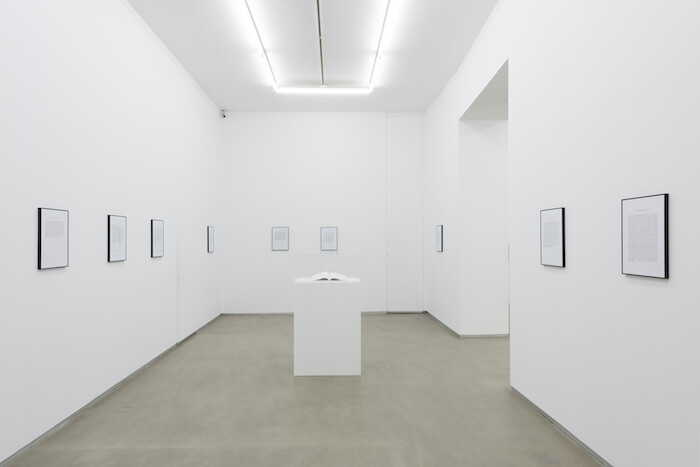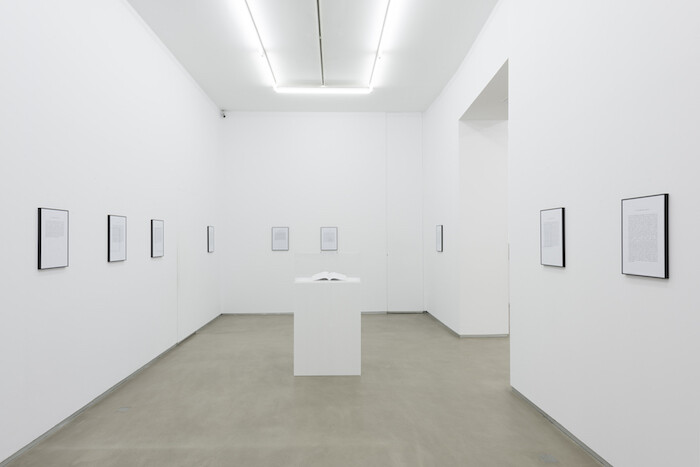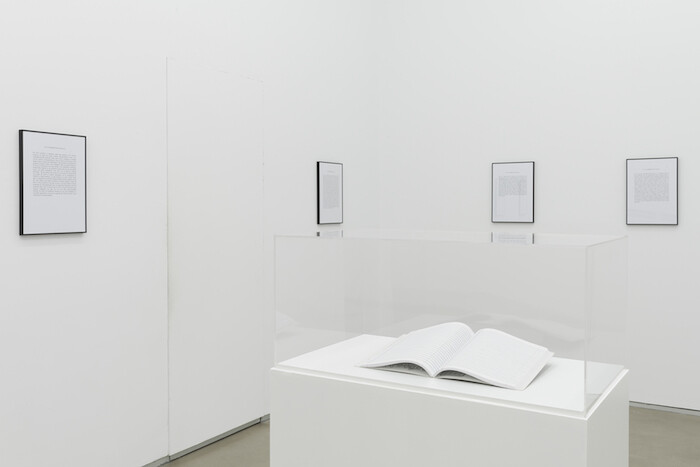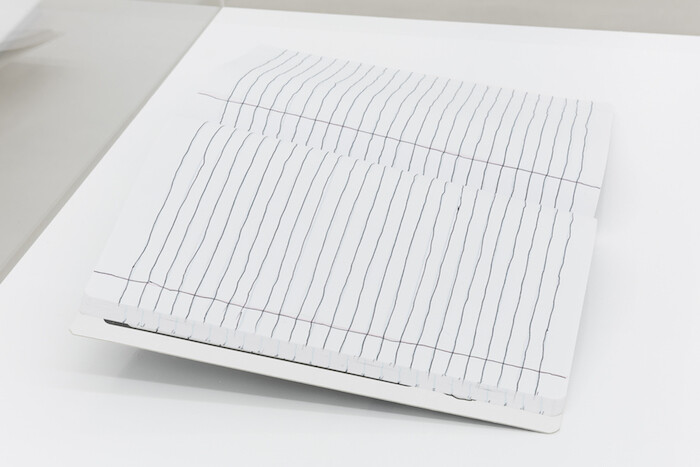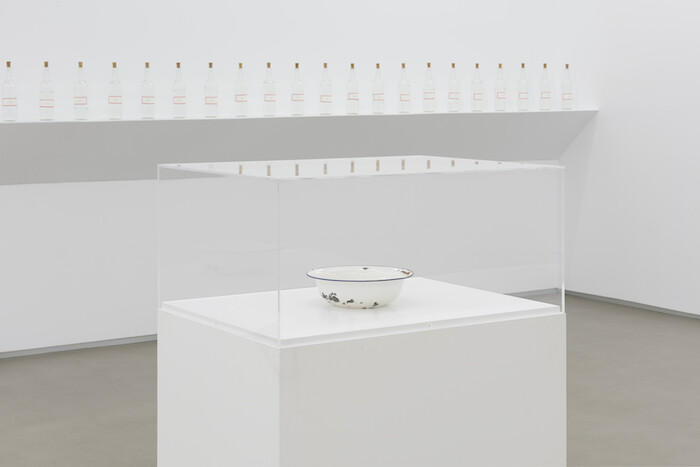The first paradox one encounters in Luis Camnitzer’s exhibition at Parra & Romero in Madrid is the apparent contradiction between its title, “Dibujos” [Drawings], and its content, two installations titled El Cuaderno Rayado [The lined notebook] and Dibujos en el Agua [Drawings on water]. Exhibited in separate gallery spaces, each installation is centered on a single object around which, through stories presented in printed texts, Camnitzer sketches out different realities.
El Cuaderno Rayado consists of a school notebook in a display case and 12 framed texts hung on the wall. The story narrated in the texts is always the same: in 1972, the artist “remade” a school notebook by drawing over the existing lines. The notebook was lost, and 40 years later he recreated it. The story is told 12 times from different angles, as performance; in relation to conceptual art and tautology; within the frame of realistic art; as cartography; in terms of the relationship between art and craft; and so on. After reading the texts, the viewer becomes aware of the second paradox, the second stimulus to reflection. By offering these differing accounts of the same event, Camnitzer sets up the issue without naming it: the nature of the artwork. Moreover, it is we, the viewers, who must form an opinion: “In 1972, I set myself the goal of creating a work in which it would be the viewer who gave meaning to things rather than the artist.”
The other installation, Dibujos en el Agua, consists of a bowl containing water, presented in the middle of the room; a shelf on which 44 glass bottles stand, each containing water and bearing a label with a number; and 5 framed texts. The story unfolds as we read these texts. In the bowl, the artist keeps drawings that he executes on the surface with a sharp stick. The immateriality of the drawing on water situates the act in the realm of “homoeopathic” as opposed to conventional “allopathic” art (from Greek allos, “other” + -patheia, “suffering”), and from there the story continues. In this case, it is easier to perceive how Camnitzer constructs the context because he situates us before the immaterial. Seeking to engage the viewer, the artist takes us to a terrain where, with a touch of humor, he dissolves rational beliefs and common sense. This is the third paradox: that by weaving a reasoned imagination, close to the fantastic, Camnitzer once again evokes questions about art.
In 1969, during the exhibition “557,087,” organized by Lucy Lippard at the Seattle Art Museum, Camnitzer and members of the New York Graphic Workshop coined the term “Contextual art” to differentiate their work from Conceptual art, which had emerged in the United States and Great Britain. The latter was a style they regarded as formalist because, though interested in language and ideas, they thought conceptual artists were not concerned with the political and social potential of art. Since that time, Camnitzer’s writings have been highly significant, not only on issues related to art, but most importantly with respect to the positioning of Latin American art as an artistic category linked to a geographical, cultural, and political entity with a shared colonial history.
The notion of context was central to his historical account of Latin American art and was a curatorial concept behind the exhibition “Global Conceptualism: Points of Origin, 1950s–1980s” which Camnitzer, together with Rachel Weiss and Jane Farver, organized for the Queens Museum of Art in New York in 1999. The exhibition framed the social and political transformations that had taken place on a global scale since 1950, and the new forms of visual language linked to political action they gave rise to. Replacing “Conceptual art” with the term “conceptualism” entailed a shift away from formal and stylistic aspects. Instead a multipolar map with various points of origin was proposed. Recognizing the existence of artistic practices outside the Euro-American sphere—practices that owed no debt to this canon and sometimes anticipated its development—ruptured the unified and universalist narrative of the mainstream. The exhibition was a landmark. “Conceptualisms” became a critical category and remains a key concept in the analysis of Latin American art, and Camnitzer’s book Conceptualism in Latin American Art: Didactics of Liberation contributed significantly to this development.
For Camnitzer, the artistic and the social form an indivisible whole, but while in his writings and curatorial work, social context is intrinsically linked to artistic practice and its assessment, in his artistic output, the work actively participates in forming the context. It is a lever the artist uses to construct an intricate context that usually includes, as in this exhibition, not only the social dimension and specific references to art, but the mind or imagination of the viewer, who must respond to the stimuli presented
